Mowers for haymaking and silage – picture gallery

Today’s grass mowers are lighter, sleeker, better behaved, more easily controlled, more durable and a whole lot bigger than they used to be.
- Mowing without conditioning
- Spreading the grass
- Conditioning tines
- Improving the ride
- Mowing back and forth
- Make mine a triple
Improved suspension and weight distribution allow machines to be worked at faster forward speeds with greater confidence, while bed designs have been developed to be strong yet cut close to the ground, with shear-bolt and disc-shear technology minimising collateral damage when things go wrong.
Look also for blade mountings that allow knives to be changed quickly without grazed knuckles yet hold them securely when discs are spinning at colossal speed.
In terms of size and sophistication, the choice has never been greater – from a simple 1.2m (4ft) tractor-mounted disc-bed mower for modest paddocks to a multi-armed 480hp self-propelled giant that can fell 14m (46ft) of forage with each pass.
Nor is there any shortage of configurations, with rear-mounted, front-mounted, combination and “reverse drive” options to extract maximum productivity from any size of tractor.
If the grass is to be spread out to dry, why bother conditioning it on the mower?
That is an increasingly asked question and one that manufacturers have responded to with plain mowers lacking a conditioning system.
These machines cost less, weigh less and do not need as much power as their conditioning counterparts, so they can be run on smaller, lighter and more economical tractors, especially when operated in front/rear and triple combinations.
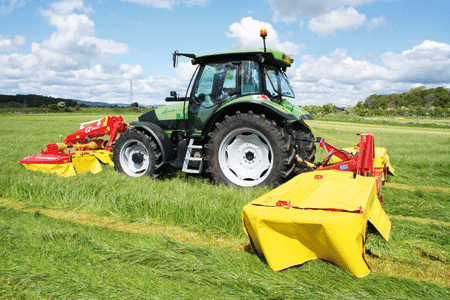
Pottinger’s plain Novadisc triple comes in two sizes covering 7.24m and 8.92m widths, with 50cm overlap between the front and rear units to ensure no unsightly uncut strips on curves nor any need for a side shift system.
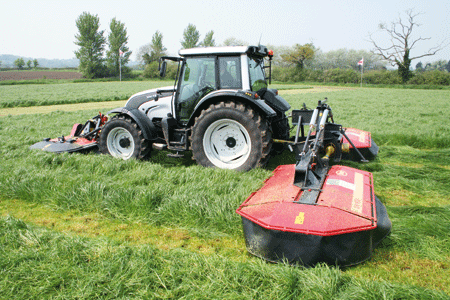
Vicon’s non-conditioning triple mower comprises a pair of CM908 plain mowers and a 296F front-mounted unit cutting 8.5m of grass in one go using a tractor of about 110hp.
However effective the conditioning system that laid them, deep swaths of lush forage take a long time to dry. So contractors and large producers using wide mowers commonly spread the grass to speed up the wilting process.
The downside is that this approach introduces another operation into silage-making sequence, requiring investment in a rake and the labour and fuel involved in operating it, together with the risk of soil contamination if the field surface is especially rough or the machine is not accurately set.
Vanes attached to the underside of the grass hood will do the job and should be adjustable to get even distribution in different conditions.
Alternatively, where the conditioning unit is the same width as the cutting deck, laying a wide, shallow swath will allow the grass to dry a little quicker than usual without having to rake it up afterwards.
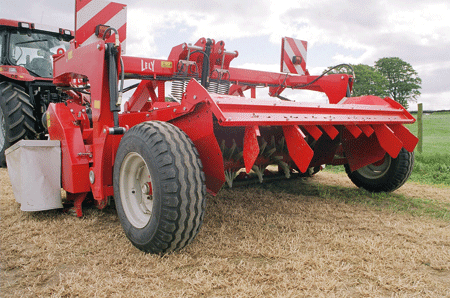
Spreading vanes on the grass hood – in this case on a Lely Splendimo – should be adjustable to get even distribution in different conditions.
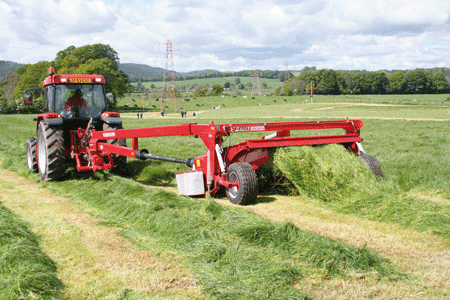
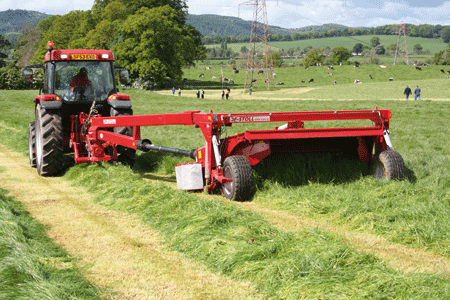
As an alternative approach, latest JF trailed mower-conditioners will lay a conventional swath (left) or with the flick of a lever a wider, shallower swath (right) that should wilt quicker.
With different rotor speeds, adjustable hood profile and the opportunity to alter forward speed, setting up a conditioning system to “bruise” the grass without damaging or consuming excessive power is a balancing act that deserves some attention.
As for the flails themselves, a “V” formation is the most common shape, with free-swinging steel tines reckoned to have the momentum to help resist blockages, while those mounted on resilient rubber blocks are said to be more likely to maintain their working position in heavy crops.
Nylon flails help reduce the weight and start-up inertia of a conditioning rotor, while also posing less of a threat to the forage harvester if one breaks free, while finger and pigtail tine designs working through a fixed comb provide an aggressive action.
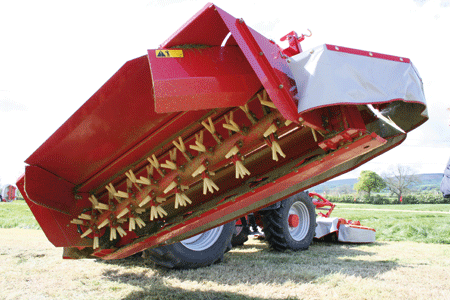
Nylon “V” tines, as on this “05” Series JF-Stoll mower-conditioner – one of a new range introduced for this year, minimise weight and pose less threat to the following forage harvester if one breaks free.

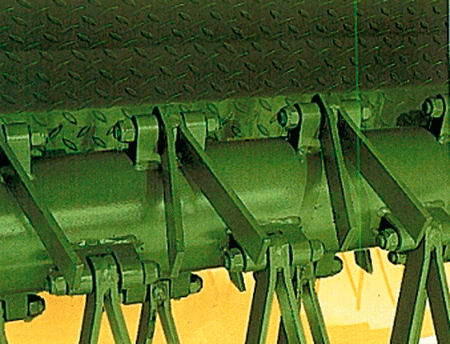
Pigtail spring tines work against a fixed comb with Fella’s “Effective” conditioning unit (left) and steel “V” tines on a Krone mower’s conditioning rotor (right).
Suspending a mounted mower’s disc cutting bed from a support arm via a central pivot rather than from a pivot at the inner end of the machine is reckoned to improve the machine’s ability to respond accurately to irregular surfaces.
It is certainly becoming a more common design feature of mounted mowers, along with more sophisticated spring and/or hydraulic suspension systems that try to cater for demand for faster mowing speeds. Operators sitting comfortably in their suspended cabs are more inclined to drive faster in the field, after all.
The mounting arrangement also improves weight distribution and reduces the height of the machines when folded for transport. Effective suspension is even more important on front-mounted mowers because of the different forces involved.
Most designs involve a linkage and spring arrangement that “pulls” rather than “pushes” the deck to improve contour-following responses while keeping the weight on the disc bed to a minimum without detracting from cutting height accuracy.
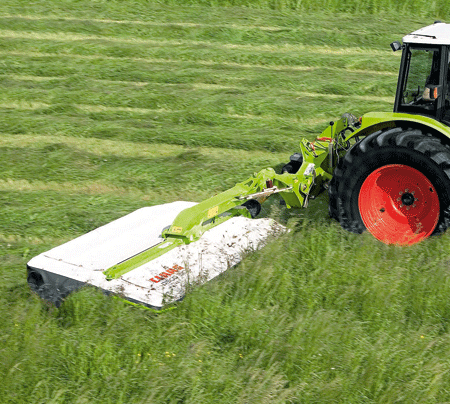
Centre-pivot mounting of the cutting assembly from a support arm – as on this Claas Disco Contour mower-conditioner – is said to improve ground-hugging performance.
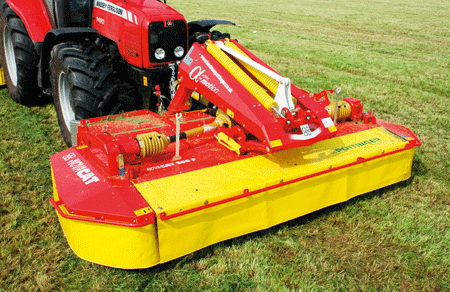
The Alphamotion suspension on this Pottinger NovaCat 306F front mower-conditioner allows the bed to tilt in all directions to faithfully follow ground contours when working at high speed.
It’s not a new concept but there more trailed mower-conditioners capable of cutting to the left and right of the tractor.
Apart from the advantages of cutting up-and-down rather than in lands or round-and-round, which means double swaths picked up by the forager will always be parallel, there is a positive conservation benefit.
Cutting in this way gives animals and game birds a better chance of escaping unscathed than when they are corralled in “lands” or at the centre of a field in the path of a fast-moving mower.
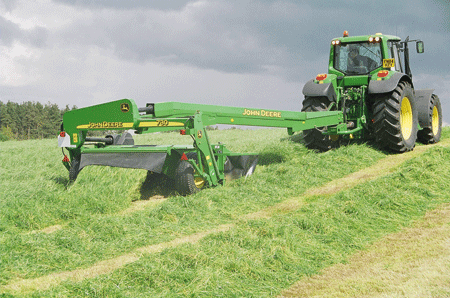
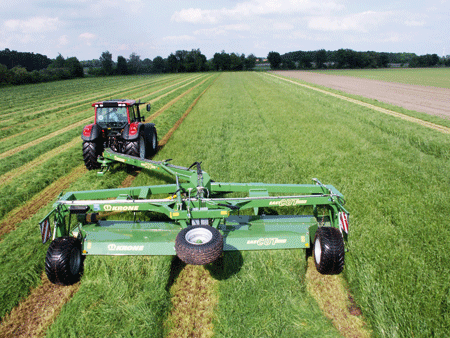
John Deere 730 with 3m (9ft 10in) cut is one of the smaller centre-pivot mower-conditioners available (left) and at 6.2m (20ft 4in), the Krone EasyCut 6210 (right) is one of the widest.
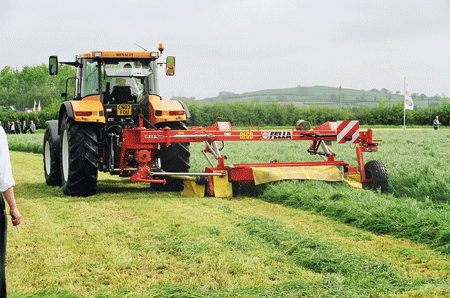
The Fella “SM” Trans-KC Turbo mower-conditioner has an unusual layout that gives it the control and manoeuvrability characteristics of a mounted mower in work and the convenience and stability of a trailed mower during transport. An end support wheel shares the machine’s weight with the tractor’s three-point linkage in both situations. In addition to the 90° normal working position, the bed can be set 25° further back to prevent the wheel snagging when cutting close to field boundaries. It comes in 3m and 4m (9ft 10in and 13ft) sizes, with or without pigtail tine conditioning.
Triple mower combinations are increasingly popular among contractors and farmers with large acreages of grass to cut ahead of a self-propelled forage harvester thanks to their combination of high output with good field manoeuvrability and easy road mobility.
Making most of the output potential with accurate steering is a challenge that can be made a lot easier with a GPS auto guidance system.
The one-front-two-rear configuration is most popular as it spreads the outfit’s weight, but having everything on the back is an alternative. Working widths are typically from just over 7m (23ft) but can go to almost 9m (29ft 6in).
A more specialist version is the Claas Disco 8700C, which can turn a redundant forage harvester into an 8.5m (28ft) cut self-propelled mower.
In weighing up different options, look for effective bed pressure control, on-the-move break-back protection and sufficient front/rear overlap adjustment to eliminate missed strips in fields that demand some tight cutting curves.
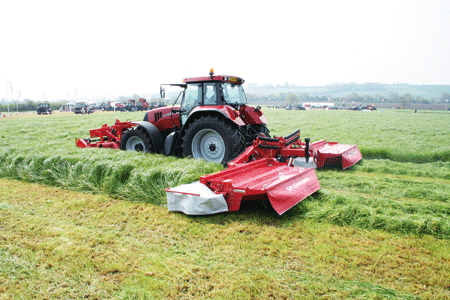
Lely’s giant triple mower – the Splendimo 900 MC – is one of the widest available it uses two wing-mounted 3.2m mower-conditioners working behind an FC320 to give an overall cutting width of 8.9m (29ft) with 350mm (14in) of overlap between the front and rear units, and needs a 200hp tractor.

